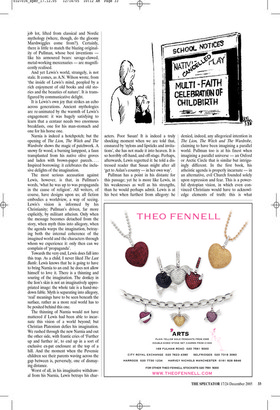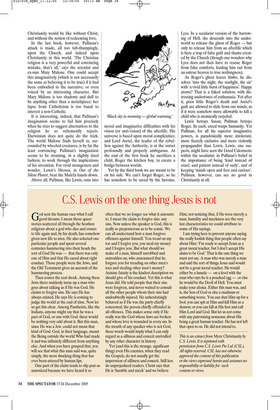War of the worlds
Caroline Moore finds the atheism of Philip Pullman more violently propagandist than the Christianity of C.S. Lewis The long-awaited premiere of The Lion, The Witch and The Wardrobe has brought the critics out in force, thick as snowflakes in a Narnian winter. C.S. Lewis, according to writers and critics as eminent, intelligent and humane as A.S. Byatt and Alison Lurie, is sexist and racist; his imaginary world is sadly derivative; and, worst of all, his writing is informed by specifically Christian beliefs.
The most vociferous of these critics is, of course, Philip Pullman — a children’s writer of genius, whose darkly blazing secularist trilogy will surely be read, like The Chronicles of Narnia, for many generations to come. The Narnia series, he claims, enshrines ‘a peevish blend of racist, misogynistic and reactionary prejudice’.
Feminists are apt to complain that the boys do the fighting (though Queen Lucy the Valiant rides to war to defend Archenland against invasion, and Jill twangs a lethal bow in The Last Battle); and that no book is named after a girl, though we have Prince Caspian and The Horse and His Boy (imagine the outcry, however, if a girl had been owned by a mare). Surely, though, it is far more important that the centres of consciousness are almost always female: Lucy is our heroine, through whose eyes we see Narnia and the Dawn Treader, though Jill takes over in The Silver Chair and The Last Battle.
Lewis’s most ‘sexist’ blunder, of course, is that he makes Peter, not Lucy, High King. It is possible, of course, to point out that in endorsing ‘patriarchal’ primogeni ture, Lewis was no more than a child of his times. One could speculate as to how Pullman might be vulnerable to attack in the future. Speciesism, perhaps, if the animal rights activists win their revolution: characters in His Dark Materials have visible, separate souls, daemons in the form of animals — but why should the evil characters have daemons in the form of serpents, wolves, frogs, beetles and the like? Vicious anthropocentric prejudice, of course. (In this brave new world, revisionist critics will hail Kipling as a revolutionary pioneer: Kaa must be one of the only good serpents in literature.) As a six-year-old, however, I did feel, quite passionately, that The Lion, The Witch and The Wardrobe was horribly Unfair. The girls got to ride on Aslan; the boys didn’t. I would still much, much rather ride upon the living gold of a vast galloping lion than be crowned High King. Perhaps this is largely a difference between the sexes — though even in an allgirls junior school, I knew that there were some who wanted to be made Milk Monitor and some who didn’t.
Racism is harder. The dark-skinned Calormenes, smelling of onions and garlic, are villains — or, rather, their culture is seen as evil. They are courteous, civilised and deeply cruel. Their economy is based on the slave trade; and they, at least, believe in the inferiority of women. Poor silly, girly, tittering Lasaraleen is the product of a society in which women are chattels and playthings.
At some level, doubtless, Calormen represents not race but religion — Islam, presumably. Yet Lewis is more open-minded than he might seem. The only obviously doctrinal passage that I noticed and positively liked as a child is the parable of Emeth, the Good Calormene. He goes through the door of death unconverted; but learns that virtuous deeds performed in the name of Tash are rewarded by Aslan, while any ‘cruelty’ done in the name of Aslan is service accepted by Tash. It is a liberating, anti-doctrinal doctrine, inclusive rather than exclusive.
There are harder charges to answer, however. Many critics have described Lewis’s imaginary world as second-hand. His centaurs, fauns, dryads, monopods, dwarfs, giants and Father Christmas are a job lot, lifted from classical and Nordic mythology (where, though, do the gloomy Marshwiggles come from?). Certainly, there is little to match the blazing originality of Pullman, whose best inventions like his armoured bears: savage-clawed, metal-working mercenaries — are magnificently realised.
And yet Lewis’s world, strangely, is not stale. It comes, as A.N. Wilson wrote, from ‘the inside of Lewis’s mind, peopled by a rich enjoyment of old books and old stories and the beauties of nature’. It is transfigured by communicative delight.
It is Lewis’s own joy that strikes an echo across generations. Ancient mythologies are re-animated by the warmth of Lewis’s engagement: it was hugely satisfying to learn that a centaur needs two enormous breakfasts, one for his man-stomach and one for his horse one.
Narnia is indeed a hotchpotch; but the opening of The Lion, The Witch and The Wardrobe shows the magic of patchwork. A snowy fir wood, a burning lamppost, a faun transplanted from his native olive groves and laden with brown-paper parcels.... Inspired borrowing: it celebrates the inclusive delights of the imagination.
The most serious accusation against Lewis, however, is that, in Pullman’s words, ‘what he was up to was propaganda in the cause of religion’. All writers, of course, have designs upon us; all fiction embodies a worldview, a way of seeing. Lewis’s vision is informed by his Christianity; Pullman’s driven, far more explicitly, by militant atheism. Only when the message becomes detached from the story, when myth thins into allegory, when the agenda warps the imagination, betraying both the internal coherence of the imagined world and the characters through whom we experience it: only then can we complain of ‘propaganda’.
Towards the very end, Lewis does fall into this trap. As a child, I never liked The Last Battle. Lewis knows that he is going to have to bring Narnia to an end: he does not allow himself to love it. There is a thinning and souring of the imagination. The donkey in the lion’s skin is not an imaginatively appropriated image: the whole tale is a hand-medown fable. Myth is separating into allegory, ‘real’ meanings have to be seen beneath the surface, rather as a more real world has to be posited behind this one.
The thinning of Narnia would not have mattered if Lewis had been able to incarnate this vision of a world beyond; but Christian Platonism defies his imagination. We rushed through the new Narnia and out the other side, with frantic cries of ‘Further up and further in’, to end up in a sort of exclusive ex-pat enclosure at the top of a hill. And the moment when the Pevensie children see their parents waving across the gap between is, perversely, one of dismaying distance.
Worst of all, in his imaginative withdrawal from his Narnia, Lewis betrays his char acters. Poor Susan! It is indeed a truly shocking moment when we are told that, ensnared by ‘nylons and lipsticks and invitations’, she has not made it into heaven. It is so horribly off-hand, and off-stage. Perhaps, afterwards, Lewis regretted it: he told a distressed reader that Susan might after all ‘get to Aslan’s country — in her own way’.
Pullman has a point in his distaste for this passage; yet he is more like Lewis, in his weaknesses as well as his strengths, than he would perhaps admit. Lewis is at his best when furthest from allegory: he denied, indeed, any allegorical intention in The Lion, The Witch and The Wardrobe, claiming to have been imagining a parallel world. Pullman too is at his finest when imagining a parallel universe — an Oxford or Arctic Circle that is similar but intriguingly different. In the first book, his atheistic agenda is properly incarnate — in an alternative, evil Church founded solely upon repression and fear. This is a powerful dystopian vision, in which even convinced Christians would have to acknowledge elements of truth: this is what Christianity would be like without Christ, and without the notion of redeeming love.
In the last book, however, Pullman’s attack is made, all too tub-thumpingly, upon the Church, and indeed upon Christianity in this world. ‘The Christian religion is a very powerful and convincing mistake, that’s all,’ says the scientist and ex-nun Mary Malone. One could accept this imaginatively (which is not necessarily the same as believing it to be true) if it had been embodied in the narrative, or even voiced by an interesting character. But Mary Malone is too shadowy and dull to be anything other than a mouthpiece: her lapse from Catholicism is too banal to interest a non-Catholic.
It is interesting, indeed, that Pullman’s imagination seems to fail him precisely when he tries to suggest alternatives to the religion he so vehemently rejects. Darwinism does not quite do the trick. The world Malone finds herself in, surrounded by wheeled creatures, is by far the least convincing: Pullman’s imagination seems to be straining, in a slightly tired fashion, to work through the implications of his invention. For vivid strangeness and wonder, Lewis’s Hrossa, in Out of the Silent Planet, beat the Mulefa hands down.
Above all, Pullman, like Lewis, runs into moral and imaginative difficulties with his vision (or anti-vision) of the afterlife. His universe is based upon moral complexities; and Lord Asriel, the leader of the rebellion against the Authority, is at the outset profoundly and properly ambiguous. At the end of the first book he sacrifices a child, Roger the kitchen boy, to create a bridge between worlds.
Yet by the third book we are meant to be on his side. We can’t forget Roger, so he has somehow to be saved by the heroine, Lyra. In a secularist version of the harrowing of Hell, she descends into the underworld to release the ghost of Roger — but only to release him from an afterlife which is here a trap of false guilt and shame created by the Church (though one wonders why Lyra does not then have to rescue Roger from false comforts, leading him out from an untrue heaven to true nothingness).
As Roger’s ghost leaves limbo, he dissolves ‘into the night, the starlight, the air’ with ‘a vivid little burst of happiness’. Happy atoms? That is a faked solution, with distressing undertones of euthanasia. Yet after it, poor little Roger’s death and Asriel’s guilt are allowed to slide from our minds, as if it were somehow more allowable to kill a child who is atomically recycled.
Lewis betrays Susan; Pullman betrays Roger. In each, creed warps humanity. Yet Pullman, for all his superior imaginative powers, is paradoxically more intolerant, more fiercely exclusive and more violently propagandist than Lewis. Lewis, one suspects, might have seen the Good Calormene within the secularist: in Pullman’s belief in the importance of being ‘kind instead of cruel, and patient instead of surly’, and of keeping ‘minds open and free and curious’. Pullman, however, can see no good in Christianity at all.




















































































 Previous page
Previous page